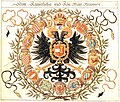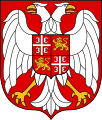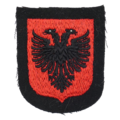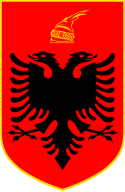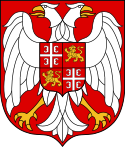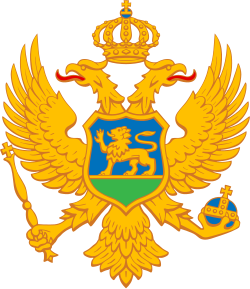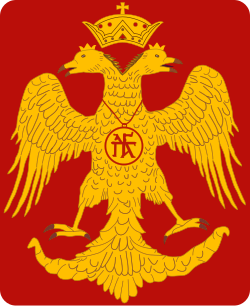Dobbeltørn
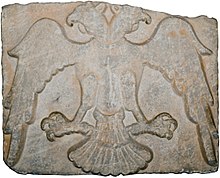
En Dobbeltørn er en allegorisk, grafisk og heraldisk figur, der gengives som en stiliseret ørn med to ørnehoveder på hver sin hals på samme krop, med en vinge til hver side, med et ben til hver side og med halefjer lige ned.
Dobbeltørn eller lignende fuglefigurer med to hoveder og vinger til siderne, findes på genstande fra hettitterne og kulturer i Mellemøsten, fra antikken og fra Amerika før Columbus. Det er teorier om, at figuren kan have symboliseret en altseende guddom, fordi den har fire øjne og kan flyve over menneskene. Dobbeltørnen skal have været anvendt som symbol for den romerske gud Jupiter. Dobbeltørnen findes også i Lagash, en Sumerisk oldtidsby, hvor den var symbolet for Ninurta, søn af Enlil og byens gud.
Fra senmiddelalderen er denne figur anvendt som symbol på en kejser. Den er anvendt i våbenskjolde for tyske, østrigske og russiske kejsere. Dobbeltørne findes både i offentlige våben såsom landskabsvåben, og i private våben såsom lavsvåben og slægtsvåben fra mange europæiske lande. I skomagerlavets segl fra 1822 i Oslo (Christiania), forekommer der en dobbeltørn, og den findes i flere danske skomagerlavs segl. I norske slægtsvåben er der en dobbeltørn i skjoldets skjoldhoved hos slægten Caspary, som indvandrede ca. 1850 fra Schweiz, mens slægten Lund fra Farsund i skjoldets 1. felt har en ørn med to halse uden hoveder. I Italien skal en dobbeltørn i skjoldhovedet symbolisere, at slægten var ghibellinere (tilhængere af den tysk-romerske kejser).
Dobbeltørn anvendes også som symbol for den ortodokse kirke.
Eksempler på anvendelse af dobbeltørne
- (c) Goran tek-en, CC BY-SA 4.0Emblem for Palaiologos-dynastiet og Det byzantinske kejserrige
- Våbenskjold for Det tysk-romerske kejser fra Huset Habsburg
- Rigsvåben for Kejserriget Østrig
- Rigsvåben for Det tyske forbund
- Rigsvåben for Det russiske kejserdømme
- Ruslands rigsvåben
- Rigsvåben for Kongeriget Jugoslavien
- Rigsvåben for Serbien og Montenegro
- Serbiens rigsvåben
- Tidligere rigsvåben for Republika Srpska
- Montenegros rigsvåben
- Uniform patch for 21. Waffen-bergdivision af SS Skanderbeg (1. albanske)
- Den græsk-ortodokse kirkes flag
- Lübecks våbenskjold
- Beograds våbenskjold
- Bolswards våbenskjold
- Groningens våbenskjold
- Nijmegens våbenskjold
- Frimærke med flaget for det uafhængige Epirus, 1913-1914
- Huset Montefeltros våbenskjold
- Provinsen Toledos flag
- Toledos våbenskjold
Litteratur
- Oluf Kolsrud: «Handverkarlags-segl fra Oslo og Christiania», tidsskriftet St. Hallvard, Oslo 1915
- Hans Cappelen: Norske slektsvåpen, Oslo 1969 (2. oplag Oslo 1976)
- Herman L. Løvenskiold: Heraldisk nøkkel, Oslo 1978
- Harald Nissen og Monica Aase: Segl i Universitetsbiblioteket i Trondheim Arkiveret 5. december 2012 hos hos Archive.is, (Trondheim 1990)
- Carl-Alexander von Volborth: Alverdens heraldik i farver, Politikens Forlag, København 1972 (oversat af Sven Tito Achen)
- Ottfried Neubecker: Heraldik. Kilder, brug, betydning, København 1979 (oversat og bearbejdet for Skandinavia af Nils G. Bartholdy)
- Carl-Alexander von Volborth: Heraldry – Customs, Rules and Styles, Dorset, England 1981
 | Wikimedia Commons har medier relateret til: |
Medier brugt på denne side
Coat of Arms of the Kingdom of Yugoslavia based on the Coat of Arms of Serbia
Flag used by the Greek Orthodox Church, in use since ca. the 1980s. Also it is the flag of Mount Athos[1] Literature: The Flag Bulletin 27. Flag Research Center. 1988. p. 105.
Forfatter/Opretter: Fabienkhan modified by Ewan ar Born, Licens: CC BY-SA 2.5
A double-headed eagle relief, 13th-century (Seljuk/Ayyubid period) architectural fragment found at Konya (now in Ince Minare Museum). It has also been suggested that the double-headed eagle may have been used as "personal insignia" by sultan Kayqubad I (r. 1220–1237).[1]
This particular design has come to be seen as "symbol of Konya"[2] and is closlely associated with Konya's role as historical Seljuq capital. "The double eagle in the city's coat of arms is a symbol of the Seljuk reign a period crucial for Konya's self-perception until today."[3] A re-drawing of the same design is used as an official emblem by the municipality[4]
An independent redrawing is used in the logo of Selçuk University, Konya, Turkey.Waffen-SS Albanian "Skanderbeg" volunteer sleeve patch. Albanian nationals were authorized the wear of an identifying sleeve patch to be worn just below the SS eagle on the upper left sleeve of the uniform. Worn by soldiers of the "21.Waffen-Gebirgs-Division der SS (or Albanische Nr.1). This type was introduced in late 1944 for use by Albanian volunteers.
Forfatter/Opretter: Dvivasm, Licens: CC BY 3.0
Bandera de la Provincia de Toledo. Flag of the province of Toledo
Serbiens våbenskjold
Forfatter/Opretter: Colossus, Licens: CC BY-SA 3.0
Photograph of the emblem found above the front entrance of the Hagios Georgios church. A symbol of the Ecumenical Patriarchate of Constantinople itself.
Coat of arms of Nijmegen (Netherlands)
Central element of the Russian imperial coat of arms.
1605 coat of arms of Rudolf II, Holy Roman Emperor. The title reads Röm[isch] Kayserlicher und Kön[iglicher] May[estät] Wappen. Armorial from Siebmachers Wappenbuch, published in 1605, during the reign of Rudolf II. The coats of arms represent the Habsburg possessions of the late 16th to early 17th century, applicable to emperors Ferdinand I, Maximilian II and Rudolf II. The coat of arms at the center (Bindenshild (Habsburg (modern)/Babenburg) impaling Castile) combines the Austrian and Castilian coats of arms, representing descent from w:Joanna of Castile (mother of Ferdinand I) of the House of Trastámara (herself the daughter of the Catholic Monarchs Isabel I of Castile and Ferdinand of Aragon).
The Bindenschild impaling Castile was first adopted as the arms of w:Philip I of Castile ("Philip the Handsome/Fair") (1478-1506), of the House of Habsburg, ruler of the Burgundian Netherlands and titular Duke of Burgundy from 1482 to 1506, as well as the first Habsburg King of Castile (as Philip I) for a brief time in 1506. In 1496 he married w:Joanna of Castile, the second daughter of Queen Isabella I of Castile and King Ferdinand II of Aragon. He was the son of Maximilian I, Holy Roman Emperor by his wife Mary of Burgundy. These impaled arms were also displayed by his successors including Rudolf II Ferdinand I and Maximilian II.
Also shown is the Order of the Golden Fleece, of which the Habsburg emperors were members since Charles V. It is crowned by an early version of the imperial Crown of Austria. The eagle is circumscribed by the coats-of-arms the major territories held by the Habsburg emperors at the time. These are the Kingdoms of Hungary (both coats of arms are shown, see en:Coat of arms of Hungary), Bohemia, Dalmatia, Croatia, Slavonia (i.e. Bosnia), the Archduchy of Austria, the Duchies of Burgundy Styria and Carniola (i.e. Slovenia),
and the County of Tyrol.Coat of arms of the Dutch municipality of Bolsward.
Lesser coat of arms of the Austrian Empire form the Congress of Vienna in 1815 until the Austro-Hungarian Compromise of 1867. It then represented the Cisleithanian territories of Austria-Hungary in the Reichsrat until 1915.
It shows the arms of Habsburg-Lorraine encircled by the chain of the Order of Golden Fleece, surmounted on the crowned Austrian imperial double-headed eagle clutching in its claws the Imperial orb, sceptre and sword, with the Imperial Crown of Rudolf above.
After 1915 the inescutcheon only displayed the red-white-red arms of Austria.Forfatter/Opretter: Valadrem (http://valadrem.blogspot.com), Licens: CC BY-SA 3.0
Escudo de Toledo
Montenegros våbenskjold (taget i brug den 13. juli 2004)
Coat of arms of Republika Srpska; time of use corresponding to the recognization of Srpska as an entity within BiH, to 2007 when the BiH constitutional court banned this coat of arms, and a new symbol was adopted
(c) Goran tek-en, CC BY-SA 4.0
The Byzantine double-headed eagle with the sympilema (the family cypher) of the Palaiologos dynasty.

